 |
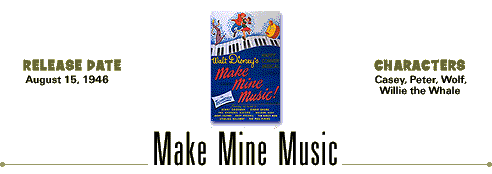 |
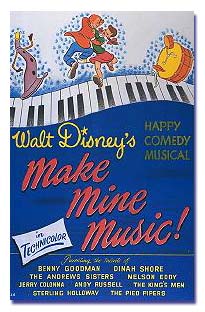 |
 en shorts are combined in a tuneful compilation.
Disney's first postwar "package" picture, produced as shorts
because financial problems prevented Walt from finding enough money
to create a full animated feature. By tying a group of shorts
together, he was able to get the production into theaters
sooner. en shorts are combined in a tuneful compilation.
Disney's first postwar "package" picture, produced as shorts
because financial problems prevented Walt from finding enough money
to create a full animated feature. By tying a group of shorts
together, he was able to get the production into theaters
sooner. |
|
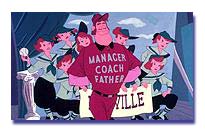 |

The segments are:
(1) "The Martins and the Coys," which deals with two feuding
families who shoot and kill off each other except for Henry Coy and
Grace Martin, who fall in love, but continue fighting after
marriage (sung by The King's Men).
(2) "Blue Bayou," originally created for "Fantasia" to accompany
"Clair de Lune," this short, sung by the Ken Darby Chorus, follows
a majestic crane who lands in a bayou, then rises again to join
another in the moonlit sky.
(3) "All the Cats Join In," with Benny Goodman and his Orchestra
playing while animated teenagers go out and dance at a malt
shop.
(4) "Without You," in which Andy Russell sings a "ballad in blue"
as a petal falls, changing to a tear; light reveals a love letter
containing lyrics of the song, and rain washes paintings onto a
window illustrating the lyrics.
(5) "Casey at the Bat", with Jerry Colonna reciting the sad story
of Mighty Casey, a baseball player who loses his touch and can no
longer hit the ball. |
|
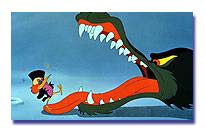 |

(6) "Two Silhouettes," with Dinah Shore singing as two figures
dance in ballet, the boy meeting, losing, and finding the girl
(live-action dancing was performed by Tania Riabouchinska and David
Lichine).
(7)" Peter and the Wolf," told by Sterling Holloway, with Peter
going with a duck, cat, and bird to catch a wolf.
(8) "After You've Gone," with the Benny Goodman Quartet and a
musical cartoon fantasy of personified instruments.
(9) "Johnny Fedora and Alice Bluebonnet," sung by the Andrews
Sisters, illustrating the romance between boy and girl hats. |
|
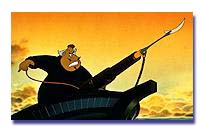 |

(10) "The Whale Who Wanted to Sing at the Met," Nelson Eddy tells
the story and sings the songs about a whale who is found singing
grand opera with a beautiful voice; a dream sequence shows the
whale at the Met as a sensation, but the return to reality shows
him being harpooned because it is believed he swallowed an opera
singer.
The film was never reissued or released in its entirety on video
in the U.S. Many of the individual segments would later be used on
television or released theatrically as shorts.
|
|
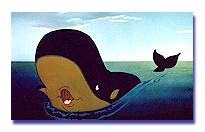 |

Premiered in New York on April 20, 1946; general production
supervisor was Joe Grant; directors were Jack Kinney, Clyde
Geronimi, Hamilton Luske, Robert Cormack, and Joshua Meador. 75
min. |
|
 |
 |
|
|
 |
 |
 |
|
|
 |
|
 |